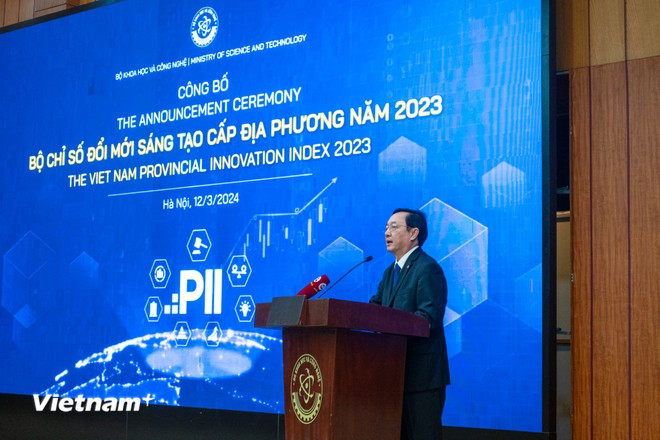 Hanoi, HCM City, and Hai Phong are the best performers in the Provincial Innovation Index 2023. (Photo: VietnamPlus)
Hanoi, HCM City, and Hai Phong are the best performers in the Provincial Innovation Index 2023. (Photo: VietnamPlus)Hanoi (VNA) - The Ministry of Science and Technology (MST) on March 12 released the Provincial Innovation Index (PII) 2023 at an event held in Hanoi on March 12.
The top 10 on the rankings consist of Hanoi (62.86), Ho Chi Minh City (55.85), Hai Phong city (52.32), Da Nang city (50.70), Can Tho city (49.66), Bac Ninh province (49.20), Ba Ria - Vung Tau province (49.18), Binh Duong province (48.64), Quang Ninh province (48.03), and Thai Nguyen province (47.75).
First PII to be announced so far
The PII 2023 is the first of its kind so far with its sub-indexes designed by the MST’s Vietnam Institute of Science, Technology and Innovation.
The index aims to supply a set of scientific and practical tools for leaders at all levels to make decisions and build and implement policies. It also serves as a source of reference on investment climate and conditions for production and business activities in localities.
Addressing the event, Minister of Science and Technology Huynh Thanh Dat described the PII as useful since it provides a scientific and practical foundation for agencies, organisations, and leaders of localities to build and implement policies to boost socio-economic development based on science, technology, and innovation.
It is also helpful for investors to learn about the investment climate, conditions, and resources for production and business activities in different localities, he added.
 Minister of Science and Technology Huynh Thanh Dat speaks at the launch of the PII 2023 results. (Photo: VietnamPlus)
Minister of Science and Technology Huynh Thanh Dat speaks at the launch of the PII 2023 results. (Photo: VietnamPlus)The results demonstrate the socioeconomic development status based on science, technology, and innovation of the 63 localities last year.
Assigned by the Government, the MST coordinated with the World Intellectual Property Organisation (WIPO) and relevant agencies to design and pilot the PII in 20 localities in 2022 to measure their innovation capacity and performance. The PII has been officially applied nationwide since 2023.
Since 2017, the Global Innovation Index (GII), published annually by WIPO, has been used by the Vietnamese Government as an important source of reference for management and governance.
The MST said the index aims to provide a general panorama of a socioeconomic development model based on science, technology, and innovation of each provincial-level locality. It points out the strong and weak points, potential factors, and necessary conditions for boosting the science, technology and innovation-based development in each province and city.
52 sub-indexes for provincial innovation assessment
The PII 2023 was compiled based on 52 sub-indexes divided into seven GII-based pillars: five input pillars reflecting socioeconomic development based on innovation, science, and innovation (regulations; human capital, research and development; infrastructure; market development level; and enterprise development level); and two output factors reflecting impacts of science, technology, and innovation on socio-economic development (products of intelligence, innovation and technology; and their impacts).
Data for the PII 2023 compilation came from three main sources. The ministries, state agencies, and organisations at the central level (for 39 of the 52 sub-indexes), and localities (for 13 sub-indexes).
The MST complied with international standards during the data analysis and report building process and then sent results to independent international experts introduced by WIPO in 2022 for assessment.
The results match the socioeconomic development status of localities, according to the ministry.
The ones ranking high on the list boast favourable natural and geographical conditions (mainly in the Red River Delta and the southeastern region), with industry - construction and service sectors accounting for large proportions of their economies along with many industrial parks, developed infrastructure, and strong scientific, technological, and innovative activities.
Meanwhile, the worst-performing ones are localities with modest socioeconomic development along with natural and geographical conditions unfavourable for the development and application of science, technology, and innovation (mainly in the Central Highlands and the northern midland and mountainous region)./.






























